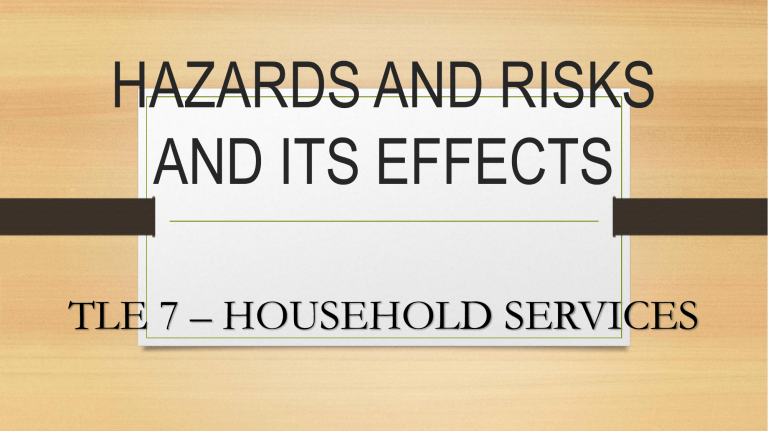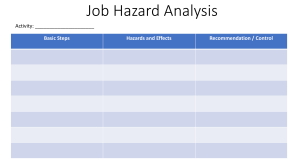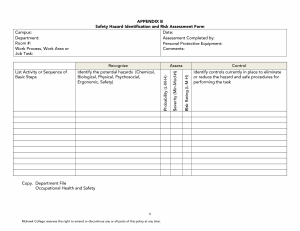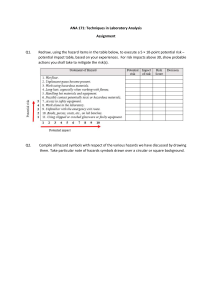
HAZARDS AND RISKS AND ITS EFFECTS TLE 7 – HOUSEHOLD SERVICES A hazard is a situation that poses a level of threat to life, health, property, or environment. Most hazards are dormant or potential, with only a theoretical risk of harm. However, once a hazard becomes "active", it can create an emergency situation. A hazard does not exist when it is not happening. A hazardous situation that has come to pass is called an incident. Hazard and vulnerability interact together to create risk. Hazards are sometimes classified into three modes: Dormant - The situation has the potential to be hazardous, but no people, property, or the environment is currently affected by this. For instance, a hillside may be unstable, with the potential for a landslide, but there is nothing below or on the hillside that could be affected. • Armed - People, property, or environment are in potential harm's way. An example of an armed hazard could be a dormant volcano that has shown signs of increased activity such as tremors, gas emissions, and ground swelling. In this scenario, the volcano is armed with the potential to erupt, and specific conditions or triggers could cause it to become an active hazard, posing a threat to surrounding areas. Active - A harmful incident involving the hazard has actually occurred. Often this is referred to not as an "active hazard" but as an accident, emergency, incident, or disaster. An example of an active hazard is a forest fire that is currently spreading rapidly due to dry conditions and high winds. In this scenario, the fire is actively causing harm by destroying vegetation, wildlife habitats, and posing a threat to nearby communities. Immediate action such as firefighting efforts and evacuation may be necessary to mitigate the impact of the active hazard. TYPES OF HAZARDS 1. Biological A biological hazard is one originating from an organism that is foreign (in presence or concentration) to the organism being affected. Many biological hazards are associated with food, including certain viruses, parasites, fungi, bacteria, and plant and seafood toxins. Pathogenic Campylobacter and Salmonella are common food borne biological hazards. 2. Chemical A chemical can be considered a hazard if by virtue of its intrinsic properties can cause harm or danger to humans, property, or the environment. Some chemicals occur naturally in certain geological formations, such as radon gas or arsenic. Other chemicals include products with commercial uses, such as agricultural and industrial chemicals, as well as products developed for home use. 3. Mechanical A mechanical hazard is any hazard involving a machine or process. Motor vehicles, aircraft, and airbags pose mechanical hazards. Compressed gases or liquids can also be considered a mechanical hazard. 4. Physical A physical hazard is a naturally occurring process that has the potential to create loss or damage. Physical hazards include, but are not limited to, earthquakes, floods, and tornadoes. Physical hazards often have both human and natural elements. Flood problems can be affected by climate fluctuations and storm frequency, both natural elements and by land drainage and building in a flood plain, human elements. Another physical hazard, X-rays, are naturally occurring from solar radiation, but have been utilized by humans for medical purposes; however, overexposure can lead to cancer, skin burns, and tissue damage. TRUE OR FALSE: 1. A hazard is a condition that poses a level of threat to life, health, property, or environment. 2. A hazard exist when it is not happening. 3. A biological hazard is one originating from an organism that is foreign (in presence or concentration) to the organism being affected. 4. Motor vehicles, aircraft, and airbags pose chemical hazards. 5. A physical hazard is a naturally occurring process that has the potential to create loss or damage. Physical hazards include, but are not limited to, earthquakes, floods, and tornadoes. Divide students into pairs or small groups. In their groups, students will read each scenario card and determine the type of hazard/risk it represents (physical, biological, chemical, or mechanical). Students should discuss and justify their answers within their groups. Divide students into pairs or small groups. In their groups, students will read each scenario card and determine the type of hazard/risk it represents (physical, biological, chemical, or mechanical). Students should discuss and justify their answers within their groups. Select the best answer: 1. What type of hazard/risk is associated with exposure to loud noises and extreme temperatures? a. Physical b. Biological c. Chemical d. Mechanical 2. Which type of hazard/risk is related to exposure to bacteria and viruses? a. Physical b. Biological c. Chemical d. Mechanical 4. Which type of hazard/risk is associated with being injured by moving parts of machinery? a. Physical b. Biological c. Chemical d. Mechanical 5. Exposure to radiation or fumes falls under which type of hazard/risk category? a. Physical b. Biological c. Chemical d. Mechanical




